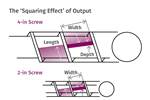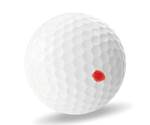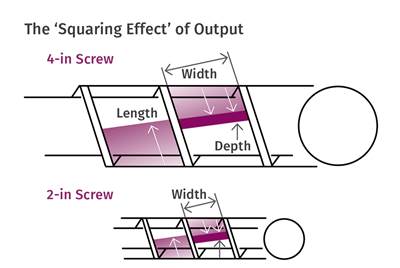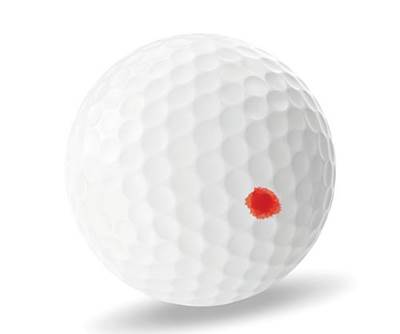How Much L/D Do You Really Need?
Just like selecting the extruder size and drive combination, the L/D should be carefully evaluated.
In the early 1960s, extruders typically had a length/diameter ratio of 20:1, and a machine with a 24:1 L/D was considered long. Since then, extruders have gotten longer, with the 30:1 to 36:1 L/D becoming the industry “standard.” Some extruders even exceed 40:1 L/D for special purposes like double venting, compounding, or high-speed processing.
What benefits does the additional length provide? Mostly increased output and improved homogenization.
Since the feed section stays approximately the same length, regardless of the L/D, the rest of the screw is devoted to melting and pumping. The deeper the screw channels, or the higher the specific output (lb/rpm), the more length you need to complete melting and develop the pressure necessary to push the polymer out the die. As designers reached these limits, extruders were built longer to handle the economic requirements to pump out more and better product.
However, there are actual limits on increasing output as L/D is increased. Usually these limits are due to the inability of the feed section to deliver more polymer. On smaller-diameter screws, that limit often is determined by screw strength. On small screws you can only go so deep in screw channels before the screw is overtorqued and fails. On larger extruders, the efficiency of feeding decreases as the channels get deeper until there is no further increase in output.

For most applications, you’ll need a longer two-stage screw to match the output of a single-stage screw.
Two-stage screws benefit more with increasing L/D because about 4-6 D is consumed in the vent area, which contributes very little to melting or pressurization. For most applications, you’ll need a 30:1 two-stage screw to match the output of a 24:1 single-stage screw.
There are actual limits on increasing output as L/D is increased.
Are there any disadvantages associated with longer extruders? Some polymers melt much easier and faster than others. Also, some processes typically have low head pressures, while others have much higher discharge pressures. Inherent viscosity differs a lot between polymers, and some shear-thin significantly while others do not (i.e., are more “Newtonian”). As a result screw performance is optimized at a variety of L/Ds rather than at any one standard L/D.
A screw that is too long for the overall processing situation can actually limit output. The limitation generally shows up as excessively high melt temperature that can cause polymer breakdown, color shift, loss of additive effectiveness, and plate out, to name a few issues. For a polymer that melts easily, the melting length should ideally be shorter, as excessively long transitions can actually reduce melting rate. The same is true of pressure development, as widely used melt pumps greatly reduce the need for long metering sections to handle the discharge pressure.
A screw that is too long for the overall processing situation can actually limit output.
As a result, the tendency to buy longer and longer L/D extruders can actually penalize overall performance. Custom extrusion houses may simply have to live with this reality because they never know what they will be running next year, and a longer extruder has more inherent flexibility than a shorter one. But if you have a dedicated process, there can be self-imposed limits with an extruder that is too long.
Just like selecting the extruder size and drive combination, the L/D should be carefully evaluated. Everyone wants the most usable output from their extruder, but if the material comes out too hot or too degraded then the singular focus on rate is actually reducing the extruder’s capability. Data such as diffusivity, power-law coefficients, melting points, head pressure, viscosity, and crystallinity should be part of the evaluation process.
About the Author: Jim Frankland is a mechanical engineer who has been involved in all types of extrusion processing for more than 50 years. He is now president of Frankland Plastics Consulting, LLC. Contact jim.frankland@comcast.net or (724) 651-9196.
Related Content
Extreme Coatings Names Jackson Director, North American Sales
Company also extends its global manufacturing footprint.
Read MoreImprove Production Rates Via Screw Design — Barrier vs. General Purpose vs. Melt Uniformity
I’m looking for a few good molders to help trial a new screw design, and share data and results for a future article to prove the benefits of a melt uniformity screw.
Read MoreGlobeius Offers Tecnocanto Vacuum Burnoff Ovens To Remove Plastics from Molds, Dies and Screws
Globeius now carries Tecnocanto vacuum burnoff ovens, which remove plastic residue without open flames.
Read MoreRead Next
Unraveling the Complexity of Single-Screw Scale-Up
Variables such as shear rates, melting rate, residence time and conductive heating are all influenced in the scale-up.
Read MoreEXTRUSION: Finding the Sweet Spot in Screw Design
The compression ratio of a screw does not provide enough detail on how it will perform. Screw design is a balancing act that takes many variables into account.
Read MoreHow to Estimate and Control Head Pressure
You rightfully worry about melt temperature, but don’t overlook head pressure, because the two are closely linked and will influence line performance.
Read More
.jpg;width=70;height=70;mode=crop)


















